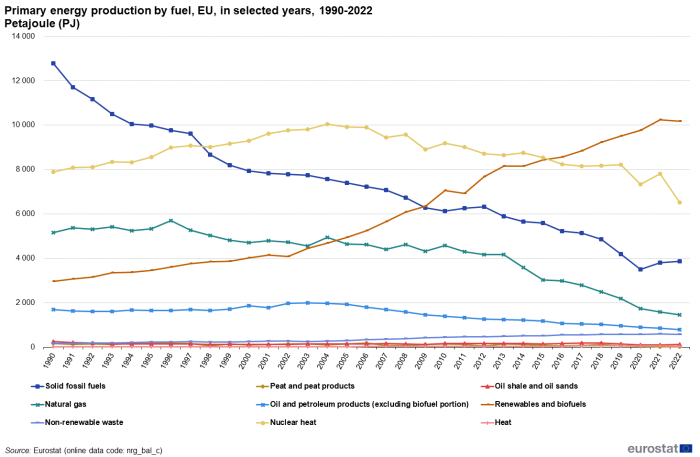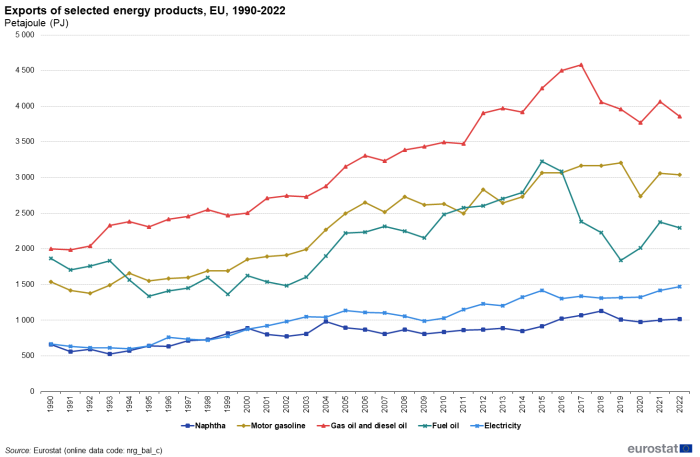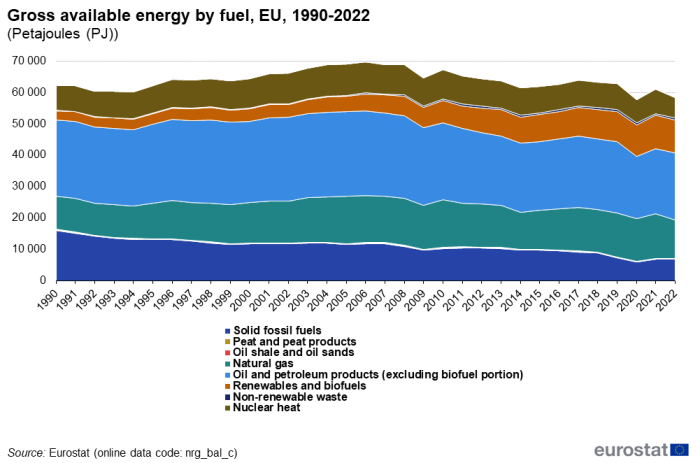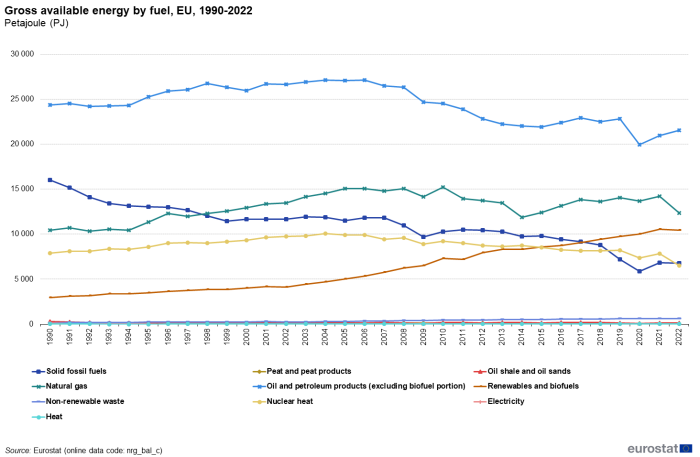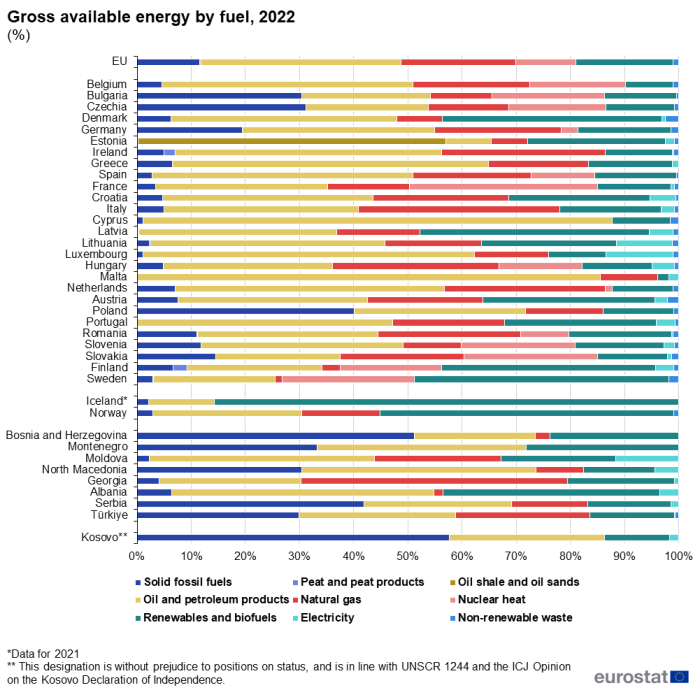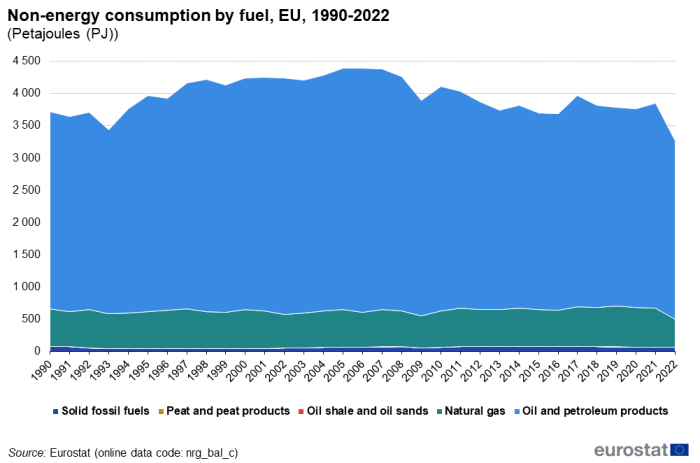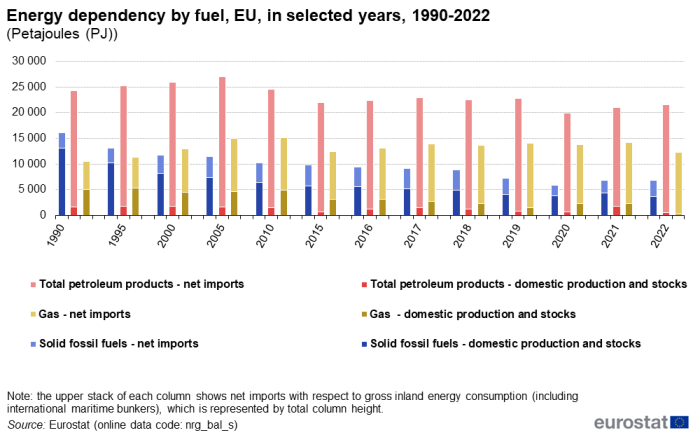Energy statistics - an overview
Data extracted in May 2024
Planned article update: May 2025
Highlights
Gross available energy, EU, 1990-2022
This article provides an overview of the energy economy in the European Union (EU) in 2022, based on annual data from each Member State. It provides trends for the main energy commodities for primary energy production, imports and exports, gross available energy and final energy consumption.
Gross available energy in the European Union in 2022 decreased compared with 2021 (-4.5 %). Oil (crude oil and petroleum products) continued to be the most significant energy source for the European economy, despite a long-term downward trend, while natural gas remained the second largest energy source. When comparing 2022 with 2021, oil increased by 2.8 %, while natural gas decreased by 13.3 %. This decrease was mostly due to the demand-reduction measures taken as a consequence of the Russian war on Ukraine. The contribution of renewable energy sources continued to increase. Renewables already surpassed solid fossil fuels in 2018 and 2019, and gained further ground in 2020 and 2022. Solid fossil fuels remained rather stable in 2022 (-0.8 %), after the lowest value ever achieved in 2020 and the increase in 2021. However, solid fossil fuels did not recover the pre-pandemic levels.
Full article
Primary energy production
Primary production of energy within the EU in 2022 accounted for 23 566 petajoules (PJ), which is 5.9 % lower than in 2021. Primary production increased for solid fossil fuels, but decreased for oil, natural gas and renewables and biofuels from 2021 to 2022. In the case of renewables, this is an exception in its long-term increasing trend (Figure 1). Renewable energies accounted for the highest share in primary energy production in the EU in 2021 (43.2 %), followed by nuclear heat (27.6 %), solid fossil fuels (16.4 %), natural gas (6.2 %), oil and petroleum products (3.3 %), and non-renewable waste (2.4 %).
Over the past decade (2012-2022), the trend in primary energy production was generally negative for solid fossil fuels, oil, natural gas, and nuclear energy. The production of natural gas saw the sharpest decline (-64.9 %), followed by solid fossil fuels and oil and petroleum products (with a drop of 38.7 % and 38.0 %, respectively). The production of renewable energies followed a clear positive trend over the same period, with a 32.6 % increase, similarly to waste (non-renewable), which saw a 22.3 % increase.
Imports and exports
The decrease in primary energy production in the EU over the past decades resulted in increased imports of primary and secondary energy products. This increase slowed down in 2020 due to a weaker demand caused by the COVID-19 pandemic and increased again in 2021 and 2022. The quantity of imported natural gas more than doubled over the period 1990-2022, reaching 14 056 PJ (Figure 2), the record import level ever registered. Natural gas is the second largest imported energy product, after crude oil, which again ranked first in terms of quantities imported, with 20 320 PJ in 2022. This is 4.5 % lower compared with a decade ago, and 5.4 % lower compared with 2019 (last year before the COVID-19 pandemic).
Exports were much lower than imports (Figure 3). In 2022, gas oil and diesel oil (around 3 857 PJ) ranked highest, followed by motor gasoline (3 037 PJ) and fuel oil (2 294 PJ).
It should be noted that data for imports and exports include intra-EU trade.
Gross available energy
Gross available energy in the EU in 2022 reached 58 461 PJ, which is 4.5 % lower than in 2021 (Figure 4) and 6.3 % lower than in 1990.
In the aftermath of the 2008 financial and economic crisis, gross available energy decreased by 6.1 % in 2009 compared with the previous year, with the sharpest drop observed in solid fossil fuels (-11.4 %), followed by oil and petroleum products (-6.3 %) and natural gas (-6.0 %) (Figure 5). After a recovery in 2010, with around 4 % rise in gross available energy, consecutive decreases were observed until 2015, when the trend reversed again. However, 2018 and 2019 once again saw a drop in gross available energy, although not nearly as significant as the one registered in 2020. The increase observed in 2021 was due to a rebound from the pandemic. In 2022, partly due to the Russian war on Ukraine, there is another decrease, recording the lowest level of the whole time series (with the only exception of 2020, the year of the COVID-19 pandemic).
As for the structure of gross available energy in 2022, oil and petroleum products held the largest share (36.8 %), followed by natural gas (21.1 %), whereas solid fossil fuels represented 11.6 %. In other words, 69.5 % of all energy in the EU was produced from coal, oil and gas. Nuclear heat and renewable energies accounted for 11.1 % and 17.9 % of the total, respectively (Figure 6).
The mix of fuels and their share in gross available energy in different countries depends on the natural resources available, the structure of a country's economy, as well as on the national choices and policies related to energy.
In 2022, the cumulated share of the main fossil fuels (i.e. coal, oil and gas) in gross available energy was below 40 % only in 2 EU Member States: Sweden 28.3 % and Finland 34.7 % (Figure 6). It should be noted that France and Sweden were also the countries with the highest contribution of nuclear heat to the gross available energy (34.8 % and 25.9 %, respectively).
In 2022, the share of solid fossil fuels in gross available energy was highest in Poland (40.2 %) and Czechia (32.1 %). The EU average stood at a much lower figure of 11.6 % (Figure 6).
In 2022, oil shale and oil sands accounted for 56.9 % of the gross available energy in Estonia, whereas the share of peat and peat products in Finland and Ireland was 2.7 % and 2.2 %, respectively.
The largest shares of oil and petroleum products in gross available energy were observed in Cyprus (86.6 %), Malta (85.5 %), and Luxembourg (61.2 %). This is due to their specific national circumstances: Cyprus and Malta are small islands, while the consumption in Luxembourg is heavily affected by "fuel tourism", owing to relatively low prices of fuels used in the transport sector.
The share of natural gas ranged from 37.3 % in Italy to under 3 % in Sweden and Cyprus. Natural gas was also a significant energy source in Hungary and Ireland, with a share of 30 % or more.
In Sweden, renewable energies accounted for almost half of their gross available energy in 2022 (49.7 %), while in Denmark and Finland this figure stood at 40.5 % and 39.4 %, respectively). The lowest results in this respect were registered in Malta (2.1 %), Belgium (8.8 %) and Luxembourg (10.6 %).
In 2022, there were 13 Member States with nuclear power plants. France had the highest nuclear share (34.8 % of nuclear heat in gross available energy), followed by Sweden (25.9 %), Slovakia (24.7 %), Bulgaria (21.9 %), and Slovenia (21.0 %).
In Luxembourg and Finland, the gross available energy in 2022 reached over 245 Gigajoule (GJ) per capita, while in Romania it was under 70 GJ per capita (Map 1, Figure 7). This indicator is influenced by the structure of the industry in each country, the severity of winter weather, as well as other factors, such as fuel tourism in the case of Luxembourg. The EU average in 2022 stood at 131 GJ per capita.
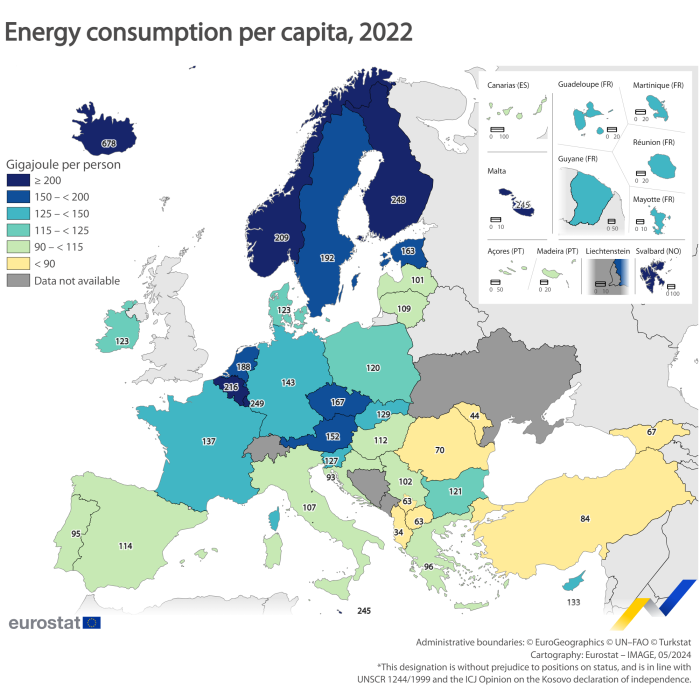
(Gigajoule per capita)
Source: Eurostat (nrg_bal_s), (demo_pjan)
Between 1990 and 2022, the EU average decreased by 12.3 %. However, at national level, the evolution varies. By far the largest increase in gross available energy per capita between 1990 and 2022 was observed in Malta (+157.7 %), followed by Portugal (+26.0 %), and Spain (+13.9 %). The sharpest decreases were registered in Estonia (-44.3 %), Lithuania (-41.5 %), Germany (-40.4 %) and Romania (-38.9 %).

(Gigajoules per capita)
Source: Eurostat (nrg_bal_s), (demo_pjan)
Note: Detailed information for all years can be found in the source file
Figure 8 shows the structural split of gross available energy in the EU by the main categories of the energy balance. In 2022, the biggest share of energy in the EU was used in energy transformation[1] (23.8 %), followed by transport activities (20.7 %), households (17.9 %), the industry sector (16.7 %), services (9.0 %) and non-energy use (5.8 %), while the remaining sectors accounted for 6.1 %.
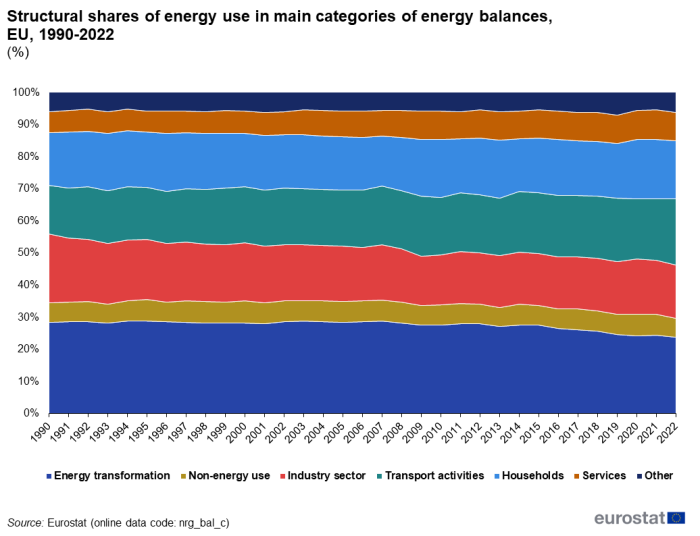
(%)
Source: Eurostat (nrg_bal_c)
Final energy consumption
Final energy consumption in the EU in 2022 was 37 771 PJ, 3.9 % less than in 2021 (Figure 9). Final energy consumption was slowly increasing from 1994 until it reached its highest value of 41 447 Mtoe in 2006. By 2022 final energy consumption decreased from its peak level by 8.9 %.
Between 1990 and 2022 the amount and share of solid fossil fuels in final energy consumption dropped significantly (from 9.6 % in 1990 to 3.6 % in 2000, 2.8 % in 2010 and 1.8 % in 2022). On the other hand, renewable energy sources increased their share in the total, moving from 4.3 % in 1990 to 5.3 % in 2000 and 8.8 % in 2010, finally reaching 12.2 % in 2022. Natural gas remained quite stable over this period, ranging from 18.8 % in 1990 to 20.6 % in 2022.
Oil and petroleum products accounted for the largest share (36.8 %) in the structure of final energy consumption in 2022, followed by electricity (23.0 %).
An analysis of the final end use of energy in the EU in 2022 reveals three dominant categories: transport (31.0 %), households (26.9 %), and industry (25.1 %) (Figure 10).
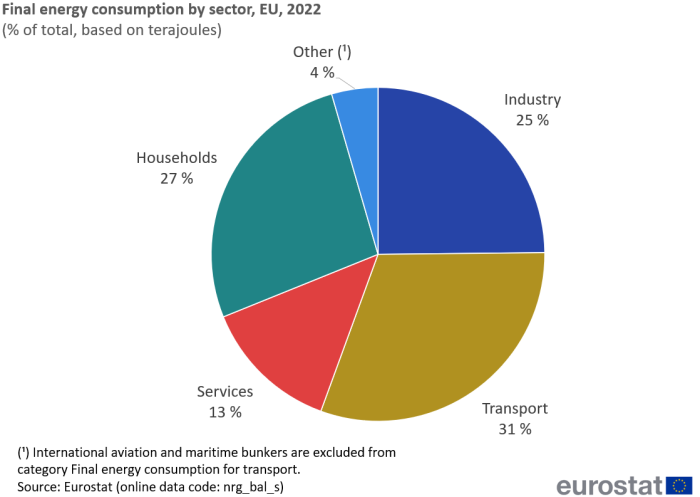
(% of total, based on terajoules)
Source: Eurostat (nrg_bal_s)
The total energy consumption of all transport modes[2] in the EU accounted for 11 718 PJ in 2022. There was a marked change in the development of energy consumption for transport after 2007. Until that year, the consumption was characterised by a steady growth, rising each year from the start of the time series in 1990. However, with the onset of the global financial and economic crisis in 2008, the consumption of energy for transport purposes fell by 1.4 %. The decline continued until 2013. By 2014, this trend had reversed, and the increase in the consumption of energy for transport activities continued all the way to 2019 (when it was 30.8 % higher than in 1990), although the 2007 levels were not reached. However, the biggest drop in energy consumption for transport was observed in 2020, -12.9 % compared with 2019, mostly due to the COVID-19 pandemic. In 2021 and 2022, the trend reversed and a 11.3 % increase was recorded in 2022 compared with 2020, but still below 2019 level.
A similar analysis for all end uses (based on the period from 2007 onwards) reveals that EU final energy consumption for industry fell overall by 17.5 % during the period between 2007 and 2022. The overall reduction in energy consumption for transport was 4.1 %. Final energy consumption by services and households decreased by 3.9 % and 2.7 %, respectively.
There were considerable differences in the development of energy consumption across various transport modes, with a rapid growth for international aviation (90.9 %) between 1990 and 2008 (Figure 12). However, 2009 was marked by a considerable reduction in energy consumption for this particular transport mode (-8.4 % compared with 2008), followed by a short period without a clear development pattern in terms of energy consumption in international aviation. In the period between 2013 and 2019 there was a steady growth in consumption, causing the 2019 levels to be 20.1 % higher than the previous relative peak in 2008. International aviation was, of course, the transport mode most severely impacted by the COVID-19 pandemic and related restrictions. Compared with 2019, the energy consumed by international aviation almost halved (-48.6 %) in 2021 and still recorded a 17.1 % decrease in 2022.
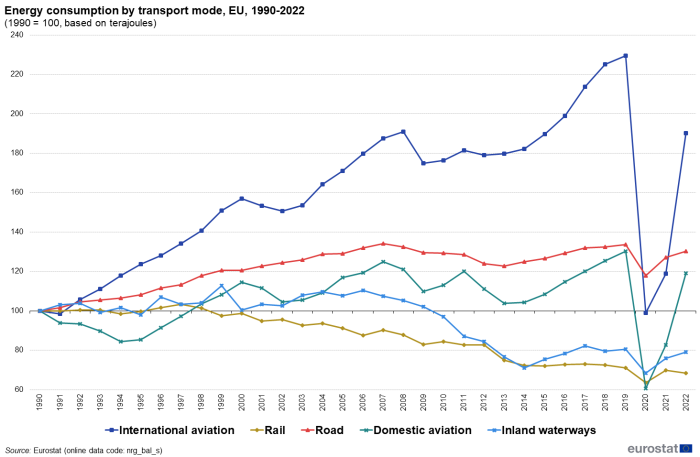
(1990 = 100, based on terajoules)
Source: Eurostat (nrg_bal_s)
As shown in Figure 12, which compares the principal modes of transport in the period between 1990 and 2022, international aviation had the biggest growth until 2019, before dropping very prominently to slightly below 1990 levels in 2020, and then recovering in 2021 and then 2022 to a similar level as in 2015. After a decline in 2020, road transport reported an increase in 2021 and then in 2022 to a level 30.2 % higher than in 1990. Domestic aviation also reported an increase in energy consumption over the period 1990-2019 (33.9 %), with a sharp decline in 2020 (-11.8 % decrease compared with 2019) and a significant recovery in 2022 to reach a similar level than in 2006. Energy consumption for rail transport continued its fall and in 2022 was around 31.5 % lower than in 1990, whereas the figure was 21.0 % lower for transport via inland waterways.
Non-energy consumption
Final non-energy consumption includes fuels that are used as raw materials and are not consumed as fuel or transformed into another fuel (for example, natural gas used in fertilizers, or bitumen used in road construction). Non-energy consumption in 2022 was 3 268 PJ (Figure 13). Oil and petroleum products accounted for 84.7 %, natural gas 13.3 %, and solid fossil fuels 1.9 % of all non-energy consumption.
Energy dependency
Gross available energy represents the quantity of energy necessary to satisfy the energy needs of a country or a region. The ratio between net imports and gross available energy indicates the ability of a country or a region to meet all its energy needs. This ratio is called energy dependency. In other words, it shows the extent to which a country or a region is dependent on energy imports. This is illustrated in Figure 14, where the total height of the stacked column represents gross available energy. The upper stack in each column shows energy imported (imports minus exports), while the lower stack represents energy produced in the EU (domestic production + stock changes). The proportion between the top of the lower stack and the total represents energy dependency.
In 2022 the EU's energy demand was highest for oil and petroleum products reaching 21 532 PJ, of which 97.7 % was imported. For natural gas the demand in 2022 stood at 12 324 PJ, with 97.6 % of it covered by imports. The production of solid fossil fuels in the EU has been in decline over the last two decades (Figure 1), as was their gross available energy. At EU level in 2022, 45.8 % of solid fossil fuels consumed were imported. Overall, the long-term trend since 1990 points to an increasing import dependency. Whereas in 1990 half of all fuels consumed were imported, the figure stood at 62.5 % in 2022.
Energy intensity
Energy intensity can be considered as an approximation of the energy efficiency of a country's economy, and shows the amount of energy needed to produce a unit of GDP. There are various reasons for observed improvements in energy intensity: a general shift from industry towards a service-based economy in Europe, a shift within industry to less energy-intensive activities and production methods, the closure of inefficient units, and more energy-efficient appliances. Map 2 illustrates energy intensity using GDP purchasing power standards (PPS), which are more suited for comparison across countries in a specific year.
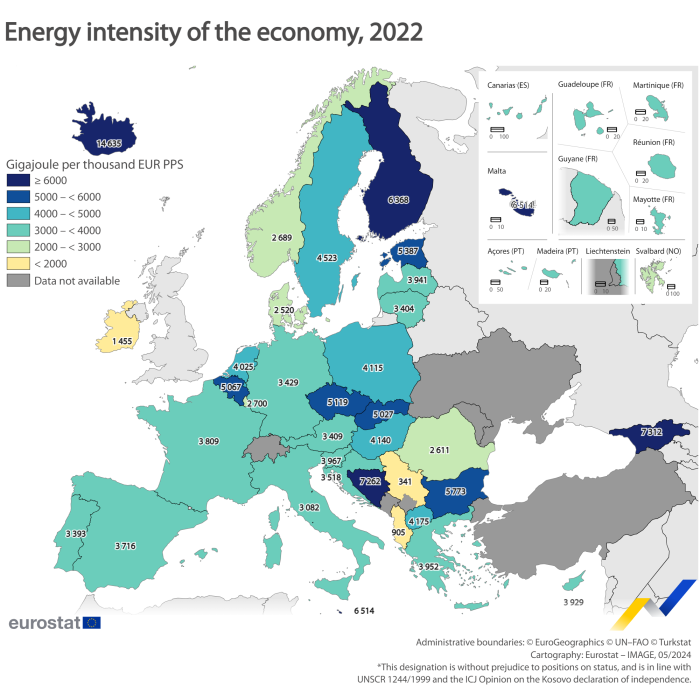
(gigajoule per thousand euro PPS)
Source: Eurostat (nrg_bal_s), (nama_10_gdp)
Figure 15 shows energy intensity using chain-linked GDP values, which are better suited for comparison of historic trends in each country. Compared with a decade ago, all EU Member States achieved improvements in terms of energy intensity.
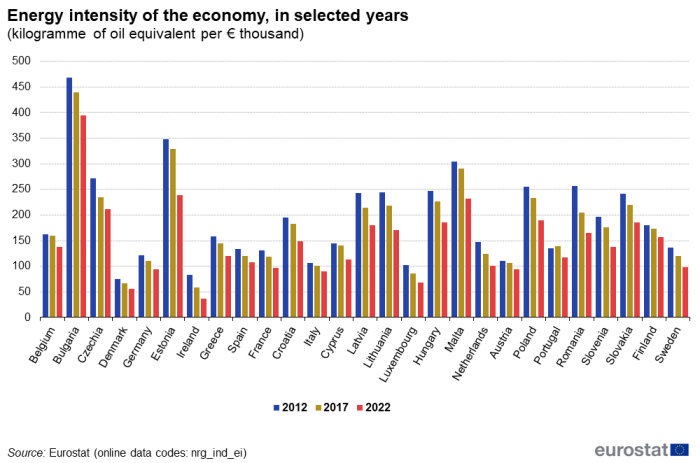
(kilogramme of oil equivalent per € thousand)
Source: Eurostat (nrg_ind_ei)
Source data for tables and graphs
Data sources & methodology
Data on energy are submitted on the basis of internationally agreed methodology in joint annual energy questionnaires (Eurostat - OECD/International Energy Agency (IEA) - UNECE). Data are available for all EU Member States and the methodology is harmonised for all reporting countries. Consequently, data comparability across countries is very high. All energy data are available in the online database. Energy balances are constructed based on Eurostat's methodology that is described in the Energy balance guide.
Context
Everyday life depends on reliable and affordable energy services, such as heating and cooling, electricity supply, and transport. Energy enables the smooth functioning of all economic sectors, from business and industry to agriculture. The EU still relies heavily on fossil fuels for its energy and faces a number of challenges to securing affordable, reliable and sustainable energy supplies. Increasing energy efficiency, improving energy productivity and reducing total consumption, while at the same time ensuring security of supply, competitiveness and access to affordable energy for all its citizens, are some of the ways the EU can improve its energy system. Energy statistics provides crucial information for policy makers on many of these issues.
The energy union strategy aims at building an energy union that gives EU consumers - households and businesses - secure, sustainable, competitive and affordable energy. The European Green Deal provides an action plan to boost the efficient use of resources by moving to a clean, circular economy, as well as to restore biodiversity and cut pollution. The plan outlines investments needed and financing tools available. It explains how to ensure a just and inclusive transition. The EU aims to be climate-neutral by 2050. The Commission has proposed a European Climate Law to turn this political commitment into a legal obligation. The Fit for 55 legislative proposals cover a wide range of policy areas including climate, energy, transport and taxation, setting out the ways in which the Commission will reach its updated 2030 target in real terms.
Energy statistics renders the complex processes of the energy we use more comprehensible and can help us understand the developments of energy consumption. It includes a broad spectrum of energy data such as annual data on crude oil, oil products, natural gas, electricity, derived heat, solid fossil fuels, renewables and wastes, covering the full spectrum of the energy balance positions from supply through transformation to final energy consumption by sector and fuel type. These are the data used in this article.
Direct access to
See also
- Energy statistics - main indicators (t_nrg_indic)
- Energy statistics - quantities, annual data (nrg_quanta)
- Energy balances (nrg_bal)
- Supply, transformation and consumption - commodity balances (nrg_cb)
- Energy indicators (nrg_ind)
- Energy infrastructure and capacities (nrg_inf)
- Stocks (nrg_stk)
- Trade by partner country (nrg_t)
Dedicated section
- Energy balances (ESMS metadata file — nrg_bal_esms)
- Energy statistics - quantities (European and national ESMS metadata file — nrg_quant_esms)
- Supply, transformation and consumption — commodity balances (ESMS metadata file — nrg_cb_esms)
- Regulation (EC) No 1099/2008 on energy statistics
Visualisations
- Explore energy data - This interactive portal helps you access several interactive tools for visualising energy data.
- A European Green Deal
- European Commission — Directorate-General for Energy — EU Energy policy
- European Commission — Directorate-General for Mobility and Transport
- Energy Community
- International Energy Agency (IEA) — Data and statistics
- OECD — Green growth and sustainable development — Greening energy
Notes
- ↑ Energy transformation includes energy lost during conversion of primary energy products into secondary energy products that are actually consumed by end users; for example crude oil refining into motor gasoline or production of electricity from coal.
- ↑ In energy balances, international aviation and maritime bunkers are excluded from final energy consumption.
